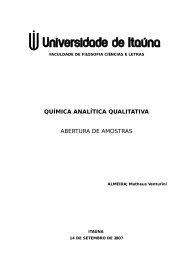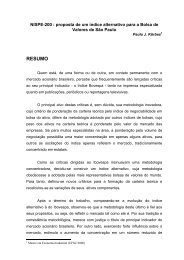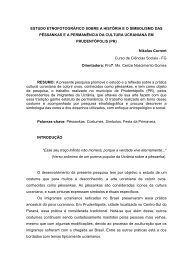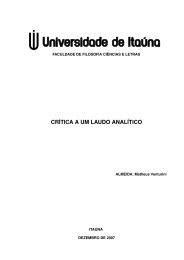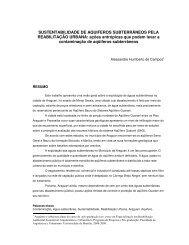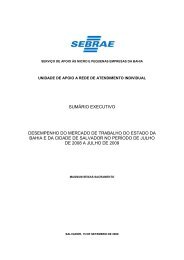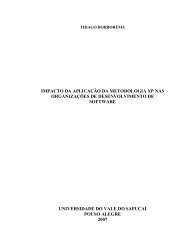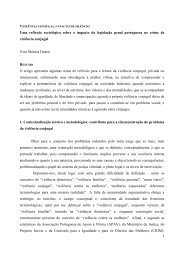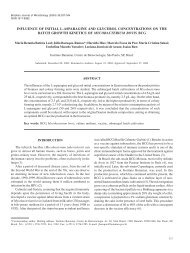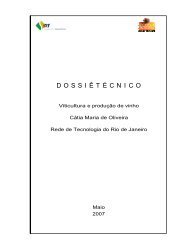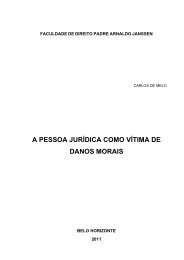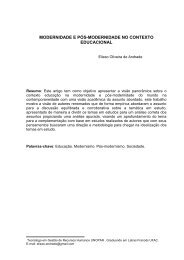You also want an ePaper? Increase the reach of your titles
YUMPU automatically turns print PDFs into web optimized ePapers that Google loves.
Czech J. Food Sci. Vol. 20, No. 4: 144–150<br />
Most of the toxic products are formed in the termination<br />
step. Aldehydes (malonaldehyde, hydroxynonenal,<br />
hydroxyhexenal), ketones, hydrocarbons, epoxides, alcohol,<br />
and other organic molecules are formed (PEARSON et<br />
al. 1983; ESTERBAUER et al. 1991; KUBOW 1992; FERRARI<br />
1998a). The presence of these compounds in foods is associated<br />
with warmed-over flavour ( TIMS & WATTS 1958;<br />
PEARSON et al. 1977) and other food sensory alterations<br />
(GREENE & CUMUZE 1981), in addition to their marked<br />
relations to the pathogenesis of cardiovascular diseases<br />
(especially atherosclerosis), diabetes, nutritional disorders,<br />
cancer and other pathologies (PEARSON et al. 1983; ES-<br />
TERBAUER et al. 1991; KUBOW 1992; FERRARI 1998a, b,<br />
1999, 2000).<br />
The aim of this paper was to evaluate lipid oxidation (by<br />
the TBA test) and its possible correlation with food quality<br />
parameters (Eh, pH, and a w ) in sausages sold on City<br />
Hall Food Markets, known as “sacolões”, in the town of<br />
Săo Paulo, Brazil.<br />
MATERIALS AND METHODS<br />
Samples<br />
During six consecutive weeks, six CHFMs marketing<br />
sausages were visited and thirty-six food samples were<br />
collected (n = 36). These methodology was important to<br />
verify that sausages were sold uninterruptedly, not only<br />
during that time period. Each sample weighing 250 g was<br />
collected in random by the food handler. With the exception<br />
of CHFM-6, which sold only poultry meat sausages,<br />
all CHFMs marketed Frankfurter sausages. It was not possible<br />
to assess the sausage producers because CHFM<br />
sellers can freely choose them, in view of low prices and<br />
availability (although the majority had chosen “Aurora’s”<br />
company). The geographic distribution of CHFMs is represented<br />
in Table 1 (FERRARI 1998b). All experiments described<br />
below were carried out in triplicates.<br />
2-thiobarbituric acid test (TBA-test)<br />
The TBA-test determines the contents of malonaldehyde<br />
(MDA), 1,3-dicarbonyl aldehyde (C 3 H 4 O 2 ) and oth-<br />
Table 1. Geographic distribution of City Hall Food Markets*<br />
of Săo Paulo (SP), Brazil, selected for sample collection<br />
Town region Locality Total per region<br />
North Vila Maria Alta 1<br />
West Butantă Joăo Moura Rio Pequeno 3<br />
Central Barra Funda Bela Vista 2<br />
Total 6<br />
Source: Diretoria dos Sacolões da Secretaria Municipal do<br />
Abastecimento (SEMAB), Săo Paulo – 1997<br />
*These CHFMs are called “sacolões”<br />
er 2-thiobarbituric acid reactive substances (TBARS) in<br />
foods. In the reaction between two TBA acid molecules<br />
and one MDA molecule, a red pigment is formed and detected<br />
spectrophotometrically by absorption of 530–532 nm.<br />
The distillation method developed by TARLADGIS et al.<br />
(1964) was used with some modifications (KUBOW 1992;<br />
TORRES et al. 1994; TORRES & OKANI 1997). Briefly, 10 g<br />
of sample and 50 ml of distilled water are put in a beaker<br />
and homogenized by virts for two minutes. The homogenate<br />
is transferred to a Kjeldahl flask. Subsequently, 47.5 ml<br />
of distilled water, 2.5 ml of HCl (4 mol/l), some anti-foaming<br />
drops, some glass beads, and 2 ml sulfanilamide solution<br />
(0.5% in 20% HCl solution) are added. The mixture is<br />
then distilled under intensive heating until 50 ml of distillate<br />
is collected in an Ernlemeyer flask. The flask is agitated.<br />
5 ml aliquots are then withdrawn and transferred to<br />
test tubes to which 5 ml of 2-TBA solution (0.02 mol/l) are<br />
futther added. The test tubes are closed and heated in a<br />
water bath at 96°C for 35 min. After cooling, absorbance<br />
at 532 nm is read using an UV-vis spectrophotometer<br />
(CE1020 model, Cecil – UK).<br />
Determination of redox potential (Eh) and pH<br />
Both Eh and pH were measured with a portable potentio-meter<br />
containing KCl electrode that was calibrated at<br />
two points (pH = 4.0 and pH = 7.0) according to the book<br />
of instructions (FERRARI 1998b).<br />
Determination of water activity (a w )<br />
a w was measured by an automatic analyzer equipment<br />
developed by Aqualab-Decagon Devices Inc., model CX-2<br />
(Washington/USA). a w was expressed by the ratio of the<br />
pressure of food water vapour to the pure water vapour<br />
pressure (FERRARI 1998b).<br />
Planning and evaluation of experiments<br />
Parametric and non-parametric tests were used to evaluate<br />
the variables in the selected places and during the<br />
determined period of time. To evaluate possible correlations<br />
between the variables studied, SPSS 7.5.1 program<br />
for Windows was used.<br />
RESULTS<br />
TBARS values of CHFM sausages (mg TBARS/kg sample)<br />
Table 2 presents the TBARS values of sausages marketed<br />
on CHFMs of the town of Săo Paulo. The mean of<br />
TBARS was X ± σ = 0.44 ± 0.23 mg TBARS/kg of sample.<br />
n–l<br />
The values ranged from 0.38 ± 0.19 mg TBARS/kg (CHFM-6)<br />
to 0.58 ± 0.31 mg TBARS/kg (CHFM-2), with limits of<br />
0.22 mg TBARS/kg and 1.08 mg TBARS/kg. The results<br />
of the analysis of variance and Kruskal-Wallis test (ANO-<br />
VA) (χ2 = 3.37; P = 0.6423) did not reveal any statistically<br />
significant differences.<br />
145




